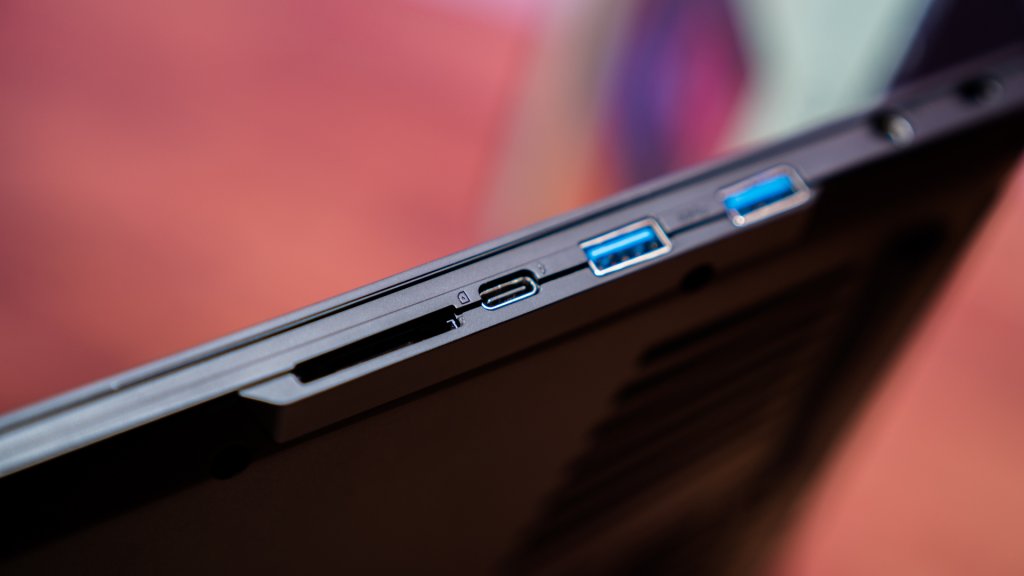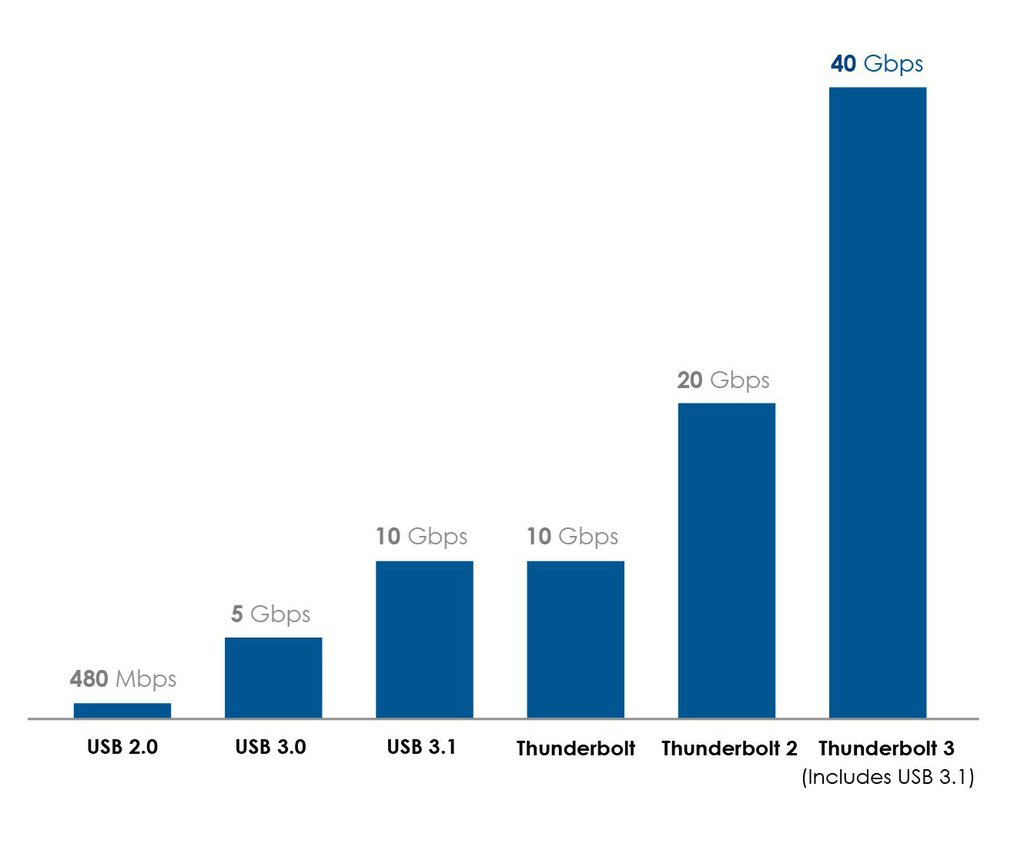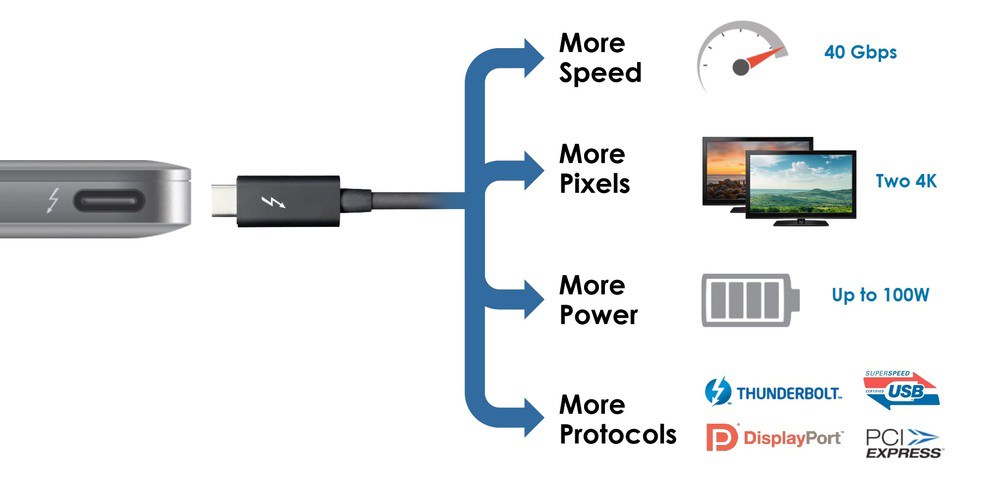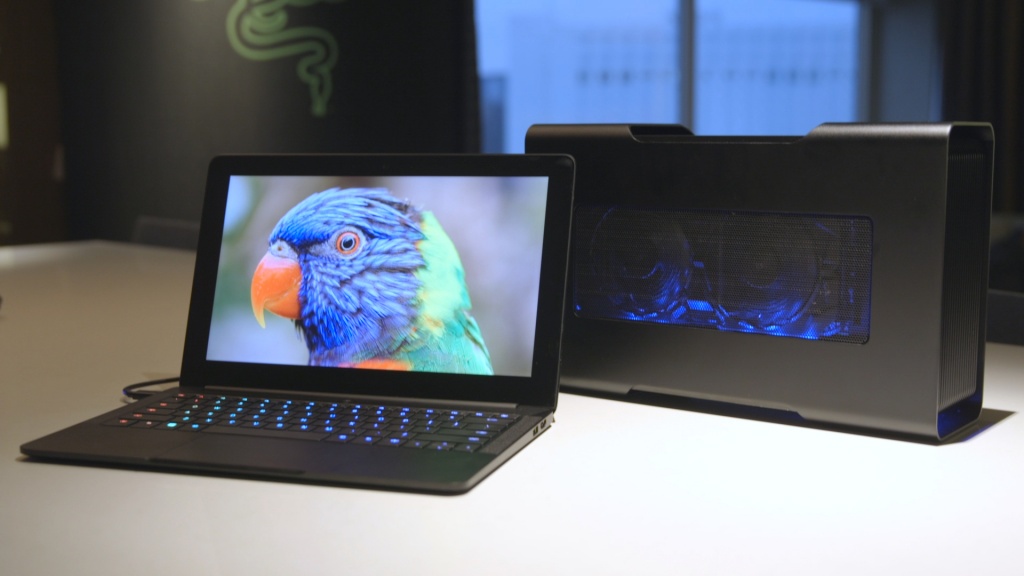Intel Thunderbolt 3 – Applications and Uses in Gaming
The third generation of Thunderbolt technology is relatively new to the market, but the basic idea is actually quite old. The first version of the precursor of Thunderbolt actually debuted in 2009. It was Intel who demonstrated how one cable could handle multiple downstream devices at the same time by sending an HD video to a monitor while sending data to a hard drive simultaneously. This was quite a big deal back then because something like this was unheard of at the time. The final product got some tweaks along the way and became what we know today as Thunderbolt.

Thunderbolt started shipping in 2011 in some early products. It supported 10Gbit/s of bandwidth and used the Mini DisplayPort connector. This would eventually become the technology that is common today, but at the time it was nothing short of special. Apple launched their new SKUs of MacBook Pro laptops in 2011 which were the first commercially available products with Thunderbolt capability. From there, Thunderbolt became better and better as it became more mature, with support for a large number of devices added later down the line.
What is Thunderbolt 3?
Thunderbolt 3 is a hardware interface that combines different data transfer protocols into a single physical interconnect for a large number of accessories and peripherals. Thunderbolt 3 uses the industry-standard USB-C connector. It should be noted that there is a big difference between Thunderbolt 3 and the standard USB 3.2 that normal USB-C connectors use.
Intel announced Thunderbolt 3 in a keynote speech at Computex 2015 and it became a big success after that. Thunderbolt 3 also ditched the Mini DisplayPort connector to a more common and robust type of connection in USB-C. Data Speeds were also increased up to 40Gbit/s. Due to its USB-C implementation and a good support network, Thunderbolt 3 has already become more common than its predecessors. Most major PC makers have already launched Thunderbolt 3 products in various form factors like desktop PCs, All-in-One PCs, mini-PCs, laptops, and even the MacBook Pro, Mac Pro, and iMac series from Apple.

Advantages of Thunderbolt 3
Thunderbolt 3 combines different protocols into a single connection so that a variety of different peripherals and accessories can be operated from a single cable. Following are the supported standards and protocols:
- PCIe 3.0 (up to) x4
- DisplayPort 1.2
- USB 3.1 Gen 2
- Thunderbolt Networking at over 10Gb Ethernet speeds
- Hot Plug
Furthermore, Thunderbolt 3 also provides an overall data transfer rate of 40Gbit/s via a USB-C bi-directional cable. Even more impressive is the fact that Thunderbolt 3 can provide up to 100W of power to a computer via the same cable, as well as 15W to additional devices. Thunderbolt can also daisy-chain up to 6 different Thunderbolt devices through a single port.
Thunderbolt can also be used to power and connect a monitor. A Thunderbolt 3-capable computer can drive not only one but two 4K monitors at 60Hz simultaneously over a single connection. Thunderbolt can also be used to transfer big files to external storage drives, or the PCIe capabilities of Thunderbolt can be utilized in gaming.
Capabilities of Thunderbolt 3
Thunderbolt 3 is packed with features and is capable of some really interesting things. Three important areas where Thunderbolt 3 has huge potential are storage, monitors, and gaming.

Storage
In the field of storage, Thunderbolt is a great technology due to its incredible 40Gbit/s bandwidth capabilities. There are a variety of USB-C accessories out there that can take full advantage of all the speed and bandwidth that Thunderbolt has to offer, and storage is one of the more important ones. Not only can the Thunderbolt storage devices transfer data at incredible speeds, but they are also a great choice for backup storage and long-term retention.
Monitors
Due to the native support of Displayport 1.2, Thunderbolt 3 devices can power and connect two 4K monitors at 60Hz. That is an impressive feat considering the fact that Thunderbolt uses the same multipurpose USB-C cable. Moreover, there are a number of dual video adapters and docks that allow a Thunderbolt-capable device to connect to two HDMI or DP monitors.
Thunderbolt 3 has also led to a new generation of mobile docks. This application is particularly useful for laptop users. Connecting the single Thunderbolt 3 cable to a compatible laptop and the dock gives the laptop access to all the accessories plugged into the dock. This application can also be used to simultaneously charge the laptop as well. Common inclusions in docks range from additional USB ports, Ethernet ports, Power Supply, video connections, media card readers, and other connectivity options as well.
Gaming
Perhaps the most exciting capability that Thunderbolt brings to the table is the possibility of gaming via the Thunderbolt link. How exactly you might be asking? Well, as mentioned earlier, Thunderbolt is capable of carrying a PCIe 3.0 (up to 4x) connection, so it is possible to utilize this in gaming.
We all know that laptops are not really the best gaming machines in the world. They tend to run hot, have limited power, and have limited battery lives so they cannot be used for intensive tasks such as gaming for long periods of time. Gaming laptops are a weird category since they are not quite the best of both worlds as one might expect. On the one hand, they do have good processors and acceptable mobile GPUs built into them, but simultaneously, they do not offer enough power headroom or thermal headroom for these components to fully stretch their legs. The most common bottleneck in the gaming performance of a laptop is its integrated GPU which more often than not, runs quickly into thermal limits due to the limited cooling potential of a laptop.
This is where Thunderbolt 3 comes in. With the power of Thunderbolt 3, laptop users with decently powerful CPUs and a Thunderbolt port can connect their machines to an External Graphics Card or an eGPU. These enclosures contain full desktop versions of graphics cards with proper cooling and external power delivery so they can theoretically deliver desktop gaming performance on a laptop.

Let’s analyze whether or not this application even makes sense.
External Graphics Cards
There is a big emerging market of laptop gaming that relies on external graphics cards and the enclosures that are required for them. This market hinges solely on the PCIe capabilities of Thunderbolt 3. The external graphics cards harness the powers of a full desktop-grade graphics card to provide the laptop with a gaming experience that is nearly impossible using mobile GPUs. If you are looking to buy an external graphics card, check out our recommendations for the best external graphics cards currently available.
Performance
The performance of the external desktop graphics cards is quite close to their actual desktop variants that you would install in DIY PCs. External Graphics Card Enclosures are designed in one of two ways. Either they come with a graphics card included, or they come as a separate enclosure with a PCIe slot in which you can install your own desktop graphics card. Enclosures of the former category are more prevalent and make the most sense from a value perspective.
There is a limitation that we have to face while using Thunderbolt to connect the graphics card to the laptop. Even though the graphics card is a full desktop card in these enclosures, the PCIe connection is limited to PCIe Gen 3 with 4x PCIe lanes. PCIe Gen 3 does not limit the performance of graphics cards significantly (you can check out the differences between PCIe Gen 3 and Gen 4 in this article) but the 4 lane limitation definitely does. This means that there will be a bit of a performance difference between the experience on the laptop as compared to the experience on a full-blown desktop PC if the card was installed directly on it.
Regardless, the performance that an external graphics card delivers is nearly impossible to match with mobile GPUs that are built into the laptop itself.
Advantages
One of the main advantages of the External Graphics Card enclosures is the cooling solution of the card. Unlike a laptop GPU, these external graphics cards are full desktop-grade cards with massive heatsinks and blower/downdraft fans for cooling. Moreover, the enclosure is also kept well-ventilated in order to provide maximum airflow to the card. This means that you will not have to deal with overheating issues on the laptop or on the GPU, and you will not lose any performance.
External GPU solutions over Thunderbolt also have the advantage that you can keep the external graphics card enclosure at your desk, and take your laptop with you when you’re out and about. This means that external graphics cards give you the choice between portability and performance. You do not have to carry around a big, bulky gaming laptop with terrible battery life and two power bricks, and you do not have to compromise on your gaming performance too. This approach can be ideal for those people who need a powerful thin-and-light laptop with a decent CPU for work, but also like to play some games in their off-time.
Disadvantages
Understandably, this approach is not perfect. While it does seem like the ideal configuration to have an external GPU enclosure at home which you can connect to your laptop using a single cable, it might not be as easy to acquire as you think. The main problem with an external GPU solution is its price. External graphics cards are wildly more expensive than their desktop variants. This is due to low production, and complicated engineering in which the enclosure has to be connected via the Thunderbolt 3 cable. External power has to be provided to the graphics card as well which is handled by the enclosure, and in some cases, these graphics cards are also water-cooled with radiators and fans in the enclosures. All of this contributes towards the final cost of these GPUs which can even cross the 4-figure mark for some high-end external graphics cards.
Add to that the fact that external GPUs do not really provide the full performance that you would get from a desktop graphics card on a custom PC. This is a limitation of the Thunderbolt 3 interface as it is limited to PCIe Gen 3 x4 link which only uses 4 PCIe lanes instead of the usual 16 to communicate with the graphics card. In some instances with slower or older graphics cards, this might be perfectly fine, but most people buying an external enclosure for their laptop are not shopping for older cards.

A Viable Option for Laptop Gamers?
So, should you consider external graphics cards over Thunderbolt 3 a viable option for gaming on a laptop? While it does definitely depend on the end-user themselves, gaming on a laptop using an external graphics card over a Thunderbolt 3 connection is definitely an unparalleled experience in the laptop space. It offers some unique functionality and ease-of-mind due to the fact that it allows the laptop to be used as a normal laptop as well as a gaming laptop simultaneously. It offers the best features of gaming laptops and improves upon them by adding more cooling and power, while also allowing the laptop to be used as a normal thin-and-light notebook if the user so desires.
With that said, the cost of entering the ecosystem of external graphics cards is a bit unreasonable. Comparable desktop graphics cards (that offer more performance due to the x16 interface) can be had for a fraction of the cost of these enclosures. There is also the argument that the laptop is certainly not portable when it is connected to an external GPU, so that removes its advantage over a traditional desktop PC. For users that want the full desktop gaming performance and do not want to pay exorbitant premiums on external enclosures, a separate desktop PC is definitely a viable choice to consider.
Final Words
Thunderbolt 3 has made some astounding advances in the field of connectivity. Before Thunderbolt, it was nearly impossible to imagine one cable or one connection that could handle such a broad spectrum of devices and applications. From storage to monitors to external graphics cards, Thunderbolt 3 has shown immense promise in some really interesting fields. Not only that, but the advancements in the field of Thunderbolt are still going on at a rapid pace as Intel, Apple, and laptop manufacturers strive to bring Thunderbolt 3 to more devices and to pack more features into this already amazing connection.





